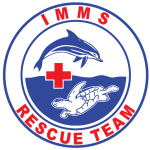A “stranded” dolphin is one that is beached on land or in very shallow water and cannot swim away on its own. If you should ever find an animal in this situation that is still alive, it is in distress and needs your help. Dolphins typically strand because of an injury or illness, and generally will die without expert assistance. You can call the IMMS Stranding Response Team at 1-888-SOS-DOLPHIN and report a stranded dolphin DEAD OR ALIVE anywhere on the Mississippi Gulf Coast.
Below is some useful information for you to follow if you ever come across a LIVE-stranded dolphin and can provide care until our stranding response team arrives. You can make a difference.
If you are located in Mississippi, Alabama, or Southeast Louisiana you can call IMMS at 1-888-SOS-DOLPHIN (1-888-767-3657) to report the location of a stranding. Even if the dolphin is dead we can gain useful information from the carcass including how the dolphin may have died, if human interaction was involved, what stock the animal may have come from, and possible details about the health of the local ecosystem.
Rule of thumb: Leave the animal exactly where it is until help arrives. If the dolphin is injured you could cause further damage by moving it. You may have to help hold it upright, keeping it’s blowhole above water. DO NOT PUSH THE ANIMAL BACK INTO THE WATER. The dolphin stranded for a reason and needs help. Please be aware that when an animal strands, it may be sick. Therefore, please use every precaution to protect yourself from any infectious diseases.
To reduce stress to the animal, do not allow people to touch the dolphin until the IMMS stranding response team arrives. Keep pets and excess on-lookers away from the animal. Refrain from touching the animal unnecessarily. Remember, it is a wild animal and is not used to human “petting”.
Dolphins can overheat fast so their skin needs to stay cool and wet. Water needs to be poured over the skin, but AVOID the blowhole. Make sure to avoid getting water or debris in the blowhole, keeping it free from obstruction so the animal can breathe.
T-shirts or towels soaked in cold/cool water can be put on the dolphin, but DO NOT COVER the dorsal fin, pectoral fins, tail flukes, and blowhole. Before applying a wet towel, cut a slit large enough for the dorsal fin to fit through and lay it on the animal. Make shade for the animal out of anything available, e.g. a tarp or beach umbrella.
Dolphins’ bodies are not made to rest on land, so to make them more comfortable you need to dig a small hole under each pectoral fin. You can also dig a hole under the chest region and fill the hole with water. This will relieve pressure on the animal’s fins and lungs yet still support the chest.
Stay away from the face and tail flukes. A dolphin’s tail is the most powerful part of its body and can cause serious injury. Dolphins are very strong and muscular animals. Under NO circumstances should you attempt to hold the tail. Be aware that dolphins can move their heads from side to side and if they hit you with their rostrum/beak (jawbone) while shaking their head, you can be badly hurt. They also have needle-sharp teeth and they will bite if they feel threatened. Contact IMMS at (228) 896 – 9182 or contactus@imms.org .

